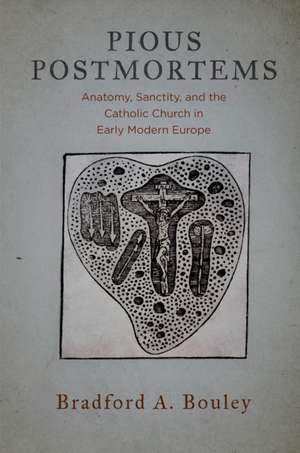Pious Postmortems – Anatomy, Sanctity, and the Catholic Church in Early Modern Europe
Autor Bradford A. Bouleyen Limba Engleză Hardback – 4 oct 2017
In Pious Postmortems, Bradford A. Bouley considers the dozens of examinations performed on reputedly holy corpses in the sixteenth and seventeenth centuries at the request of the Catholic Church. Contemporary theologians, physicians, and laymen believed that normal human bodies were anatomically different from those of both very holy and very sinful individuals. Attempting to demonstrate the reality of miracles in the bodies of its saints, the Church introduced expert testimony from medical practitioners and increased the role granted to university-trained physicians in the search for signs of sanctity such as incorruption. The practitioners and physicians engaged in these postmortem examinations to further their study of human anatomy and irregularity in nature, even if their judgments regarding the viability of the miraculous may have been compromised by political expediency. Tracing the complicated relationship between the Catholic Church and medicine, Bouley concludes that neither religious nor scientific truths were self-evident but rather negotiated through a complex array of local and broader interests.
Preț: 431.87 lei
Nou
Puncte Express: 648
Preț estimativ în valută:
82.65€ • 85.63$ • 68.98£
82.65€ • 85.63$ • 68.98£
Carte tipărită la comandă
Livrare economică 21 martie-04 aprilie
Preluare comenzi: 021 569.72.76
Specificații
ISBN-13: 9780812249576
ISBN-10: 0812249577
Pagini: 224
Dimensiuni: 162 x 239 x 23 mm
Greutate: 0.45 kg
Editura: MT – University of Pennsylvania Press
ISBN-10: 0812249577
Pagini: 224
Dimensiuni: 162 x 239 x 23 mm
Greutate: 0.45 kg
Editura: MT – University of Pennsylvania Press
Notă biografică
Bradford A. Bouley teaches history at the University of California, Santa Barbara.
Descriere
In Pious Postmortems, Bradford A. Bouley considers the examinations performed on reputedly holy corpses in the sixteenth and seventeenth centuries at the request of the Catholic Church. Bouley concludes that neither religious nor scientific truths were self-evident but rather negotiated through a complex array of local and broader interests.
